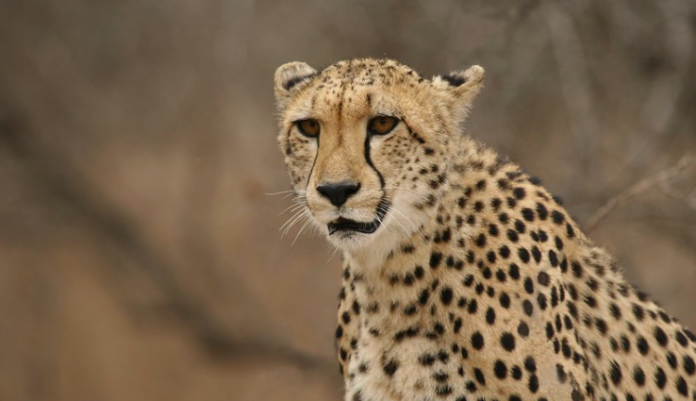
When the word “cheetah” falls in our ears, the image of a wild animal that is known for its amazing agility and speed automatically emerges in the mind.
Cheetahs (Acinonyx jubatus) are big cat according to their size but they are quite different from other big cats like Lion, Tiger, jaguar and Leopard which roar and have retractable claws however cheetahs never roar but purr like small cats and possess semi retractable claws to maintain traction on the ground i.e. offer extra grip in its high-speed pursuits. They are placed in subfamily felinae of family felidae with small cats. While all big cats are kept in subfamily pantherinae of the same family felidae.

At present there are only four cheetahs left in the whole of India and that too in the zoological parks of Hyderabad and Mysore. About seven decades i.e. 70 years ago this beautiful wild animal had become extinct from the forests of India.
It is said that in the year 1948 there were only three cheetahs left in country. It was a matter of misfortune that these three were also killed by the a Maharaja of Madhya Pradesh in his hunt. After that an attempt was made to find this beautiful beast for about four years but it all went into vain and finally in the year 1952 this beautiful big cat was declared extinct from the forests of India by the government. Main reason for extinction of cheetahs from indian forests was sport hunting and were also tamed and used to hunt antelopes and deer by the aristocracy.
Now cheetahs, around only 7000 in numbers, occupy only nine percent of its global habitat in 16 countries of Africa apart from Iran in Asia.
Studies also suggest that the word cheetah is derived from the Sanskrit word ‘chitrakaya’, which means ‘multi-colored or the spotted one’ and this proves that there must have been a time when the number of cheetahs on the soil of India was abundant. Cheetahs have mention in vedas especially Rigveda and Atharvaveda and are also seen in cave paintings of neolithic period in central India.
With about 90 cm in height, 130 cm in length and an average weight of 50 to 65 kg, and its long legs, small head, slender body and small dark spots on skin and black tear line on face give him very beautiful and attractive look.
The black tear marks on its face reduces the strong sunlight, making it easier to hunt even in harsh sunlight.
The long tail and special body structure earn the cheetah the title of the “fastest running land creature” on the earth. Cheetah can accelerate up to a speed of about 95 kilometers per hour in just three seconds, which is much more than today’s modern sports car. Not only this, Cheetah is adept at running up to a speed of about 113 kilometers per hour for few moments.
It is said that the main diet of cheetahs in the forests of India used to be black buck, chinkara, and cheetal deer, but there is some evidence that cheetahs had also made other animals including sheep, goat, dog and nilgai their prey.
The extinction of such important large cat from the forests of India became a matter of concern for the government, and in 1970 the then government started trying to reintroduce cheetahs from Iran to the forests of India. After decades long talks between Iran and India, the talks were stalled as india underwent emergency and Shah of Iran fell from power. Later on Iran demanded Asiatic lions from India in exchange for cheetahs, but as the number of Asiatic lions was already low in India, so government of India rejected Iran’s offer. And as a result of which the ongoing talks with Iran regarding cheetahs were completely stopped.
But the Ministry of Environment and Forests and Wildlife Institute of India were firmly committed to bring cheetahs to the country and in 2009 it was decided to reintroduced them from Africa.
In this regard, a meeting was organized by the Wildlife Institute of India in Gajner, Rajasthan on the instructions of the Ministry of Environment and Forests, in which the wildlife Institute of India WTI, IUCN, Cheetah Conservation Fund and other NGOs including high officials of most of the states of the country participated and a strategy was chalked out to select the place where the cheetahs brought from Africa would be rehabilitated. After a long study, in January 2022 it was decided to reintroduce the cheetahs brought from Africa in ‘Kuno-Palpur National Park’ in the state of Madhya Pradesh. In this regard an agreement between India and Namibia was signed on 20th July 2022.
It is a matter of great pride for all the countrymen that on 17th September 2022, a total of eight cheetahs brought from Africa, that is four males and four females are being reintroduced to 344.6 sq km ‘Kuno-Palpur National Park’ in Madhya Pradesh. Later on Nauradehi in Madhya Pradesh and border area of Shahgarh in Rajasthan will also become cheetah’s new destination.
If all these efforts become successful, then in the coming days all of us will again be able to see this beautiful wildlife roaming, running and hunting in the forests of India.
=> Dr RK SINGH, WILDLIFE EXPERT, COLUMNIST & POET












